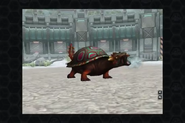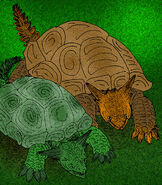No edit summary |
No edit summary |
||
| Line 49: | Line 49: | ||
[[Category:Cenozoic Reptiles]] |
[[Category:Cenozoic Reptiles]] |
||
[[Category:Middle Cretaceous Reptiles]] |
[[Category:Middle Cretaceous Reptiles]] |
||
| − | [[Category:Late |
+ | [[Category:Late Cretaceous]] |
Revision as of 01:52, 1 April 2019
Meiolaniidae was an extinct family of large, possibly herbivorous turtles with heavily armored heads and tails. They are best known from the last surviving genus, Meiolania, which lived in the rainforests of Australia from the Oligocene until the Pleistocene, and relict populations that lived on Lord Howe Island and New Caledonia until 2000 years ago. The family was once thought to have originated in Australia sometime in the Oligocene, when the earliest Meiolania first appeared. However, due to the discovery of South American meiolaniids, including Crossochelys in Eocene Argentina, and the problematic Niolamia argentina (problematic, as researchers are unsure whether it dates from the Cretaceous, or Eocene), it is now believed that the meiolaniids appeared sometime prior to the breakup of Gondwana during the Cretaceous.
Genus and Species
Crossochelys corniger
Crossochelys corniger (named by Simpson, 1937) is an extinct species of South American turtle.
Niolamia argentina
Ninjemys oweni

Ninjemys oweni.
Ninjemys oweni ("Owen's Ninja Turtle") was a large meiolaniid turtle from Pleistocene Queensland. It resembled its larger relative, Meiolania, save that the largest pair of horns on its head stuck out to the sides, rather than point backwards. It was originally thought to be a member of the genus Meiolania, but, anatomical differences lead to its placement in a new genus, which was named in honor of the Teenage Mutant Ninja Turtles. Like other meiolaniids, N. oweni is believed to have been an herbivore. Its weight is estimated at 200 kg.
Meiolania
Meiolania ("small roamer") is an extinct genus of cryptodire turtle from the Oligocene to Holocene, with the last relict populations at New Caledonia which survived until 2,000 years ago. The animal was rather large, measuring 2.5 metres (8.2 ft) in length, making it the second-largest known nonmarine turtle or tortoise, surpassed only by Colossochelys atlas from Asia, which lived in the Pleistocene. It lived in Australia and New Caledonia. Remains have also been found on the island of Efate in Vanatu, associated with settlements from the Lapita culture. Meiolani turtles fed on plants. Its surviving relatives are the cryptodire turtles of South America. The Meiolania specimens which were once living on New Caledonia and Lord Howe Island were much smaller than their giant relatives from the Australian continent. When the first fossil remains (a vertebra) were found, they were originally thought to be from a large Monitor Lizard, similar to, but smaller than Megalania, so the genus was named accordingly. Later, when more remains were found, it was realized that the "small roamer" was actually a turtle, and not a lizard. Synonyms include Miolania and Ceratochelys.









